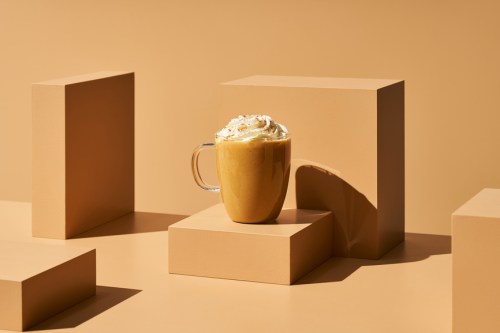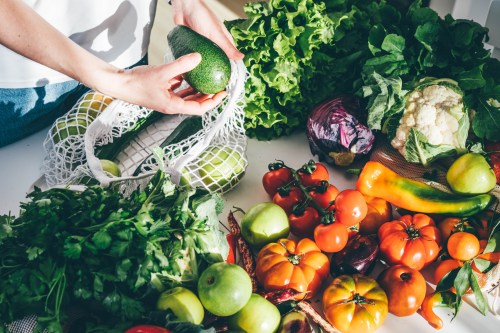The ‘Big 4’ (Very Basic) Barista Tricks To Try at Home for Better Coffee, From the Global Head of Coffee Education at Starbucks
Discover the four fundamentals of coffee to follow for consistently perfect brews, according to a Starbucks coffee expert.

Fam, it’s officially PSL season, which can only mean one thing: daily coffee runs to Starbucks are a go. Truth is, despite all the pumpkin spice #duuupes swirling around social media, nothing quite slaps like a venti pumpkin cream cold brew made by a Starbucks pro.
Experts in This Article
manager of global coffee education and experience at Starbucks
In the food service industry, they say, consistency is key—which is true when it comes to Starbucks’ around the globe; no matter where you go their coffee almost always tastes virtually the same. Is it some kind of secret barista sorcery? Nope. In truth, the folks at Starbucks have established what they deem “the four fundamentals of coffee,” that’s the success behind their consistently great-tasting beverages everywhere you go. We caught up with a Lennon Fediw, who’s in charge of coffee education and experience at Starbucks and has nearly two decades (!) worth of experience in the coffee industry to learn what it really takes to make the perfect cup of joe.
What are the four fundamentals of coffee?
Even after decades of making coffee nearly every *groggy* morning it’s quite possible that most of us haven’t been clued in on the four fundamentals of making coffee… until now. As the manager of global coffee education and experience at Starbucks, Fediw’s number one responsibility is ensuring coffee tastes great and that every cup meets Starbucks’ high-quality standards. In other words, a day at the “office” for Fediw can mean tasting over 400 cups of coffee daily—talk about quality assurance and a major buzz.
But after tasting so much coffee, how can Fediw even tell a good cup apart from a bad one? It all boils down to (pun intended) the four fundamentals of coffee: proportion, grind, water, and freshness. (And these apply to all types of coffee—although number three will be slightly different when making cold brew.) So, let’s break each one down.
1. Nailing the perfect proportions
One of the most important make-it-or-break-it factors for making coffee is nailing the proportions, which Fediw says is two tablespoons (10 grams) of ground coffee for every six ounces (180 milliliters) of water. “Too few coffee grounds result in over-extracted or bitter coffee. Too many grounds result in under-extracted coffee that does not achieve the full flavor of the blend,” Fediw says.
Proportion is the most common coffee-making mistake, according to the coffee expert. However, he reassures us that it’s also the easiest mistake to correct. Phew.
One of the most important make-it-or-break-it factors for making coffee is nailing the proportions, which Fediw says is two tablespoons (10 grams) of ground coffee for every six ounces (180 milliliters) of water.
2. Knowing that coffee isn’t one-grind-fits-all
Coffee certainly isn’t one-grind-fits-all. Instead, adjusting the size of the coffee grind is imperative if good-quality coffee is the goal. “Different brewing methods require different grinds. A grind that is too fine will trap water and result in a bitter, unpleasant brew. A grind that is too coarse leaves coffee weak and without distinguishing characteristics or flavors,” Fediw says. But when in doubt, he suggests a coarser grind will generally be a bit more forgiving. “Over-extracted coffee tastes much worse than under-extracted coffee, so when in doubt as to the brewing method, always err on the coarse side.”
And if you’re grinding the beans yourself, Fediw recommends using a burr grinder—instead of a blade grinder—whenever possible, which will help ensure the grind is more consistent, while reducing heat exposure which can disrupt the delicate oils and composition of the fresh coffee beans.
That said, if you’re ever unsure about the appropriate grind protocol, Fediw says you can always ask a Starbucks barista for a little help deciphering which type of grind is the right one for you (and your brewing method). “When you buy whole bean coffee at Starbucks, you can ask your barista to grind the beans for you, picking the perfect grind for your preferred brewing method. For example, the beans will be more coarsely ground if you are brewing on a coffee press.”
3. Using the right type of water
Although water might seem like an afterthought, Fediw says don’t be fooled. In fact, water can single-handedly make or break your cup of joe, which is why the folks at Starbucks take special measures to ensure they’re always using the best type of water for making coffee. “While it may not seem like an important ingredient, coffee is 98 percent water. The type of water used when brewing greatly affects the final taste,” Fediw says.
To ensure water quality won’t be the sneaky reason behind an off-tasting cappuccino, he recommends always using clean, fresh water that’s filtered or free of impurities. “Avoid soft water or well water, and use fresh filtered water when brewing coffee at home. A simple water filter pitcher with activated carbon helps brew the best tasting cup of coffee at home,” Fediw says.
And while we’re on the topic of water, Fediw adds that H2O heated to “just off the boil” or between 195-205°F is the ultimate sweet spot for extracting coffee’s full range of flavors. “Water that is too cool will mute the flavor and dull the coffee’s aroma,” Fediw says.
4. Maintaining coffee freshness
Simply put: Coffee, moisture, and oxygendon’t mix well. That’s why Fediw suggests always storing coffee in an airtight container at room temperature to keep it in tiptop shape. And contrary to popular belief, coffee beans shouldn’t go in the refrigerator or freezer either. “We don’t recommend storing coffee in the refrigerator or freezer as the cooling function used in them can cause moisture to condensate on the coffee which dulls the flavor. The best place to store coffee is in an opaque, airtight container or the original bag.”
“We don’t recommend storing coffee in the refrigerator or freezer as the cooling function used in them can cause moisture to condensate on the coffee which dulls the flavor. The best place to store coffee is in an opaque, airtight container or the original bag.”—Lennon Fediw
And although this may feel a little extra (especially without a bit of caffeine running through your veins), Fediw urges us to always use fresh coffee grinds each time we’re making coffee. Okayyyy, we hear you. But if we must, Fediw recommends using coffee grinds within one week of being ground, at most.
The unofficial *fifth* fundamental of coffee: Have fun
Coffee making should be fun and isn’t nearly as intimidating as it sounds. “Coffee is approachable, and brewing a great cup is achievable, and doing the little things right helps avoid a lackluster cup of coffee,” Fidew says. Plus, the best brew is ultimately the one that’s available and enjoyable to you.
An RD explains the benefits of drinking coffee:
Sign Up for Our Daily Newsletter
Get all the latest in wellness, trends, food, fitness, beauty, and more delivered right to your inbox.
Got it, you've been added to our email list.










